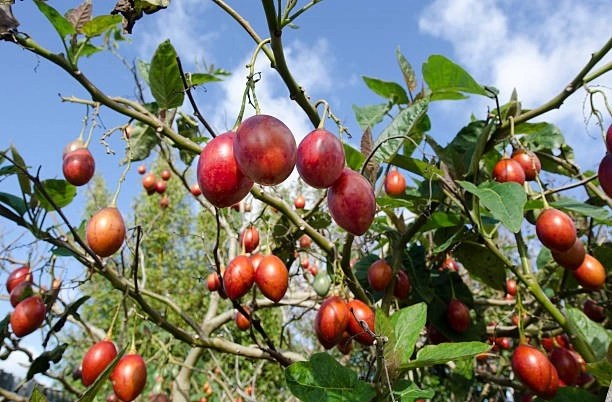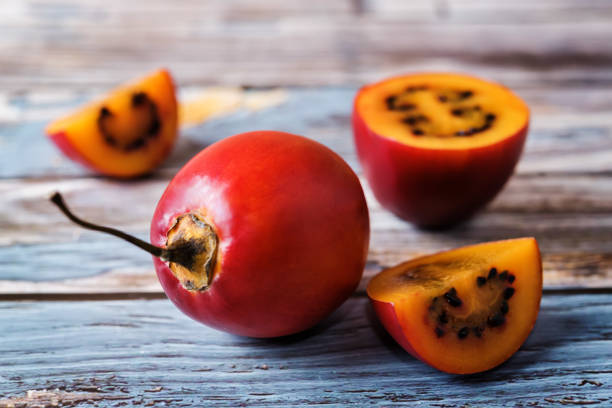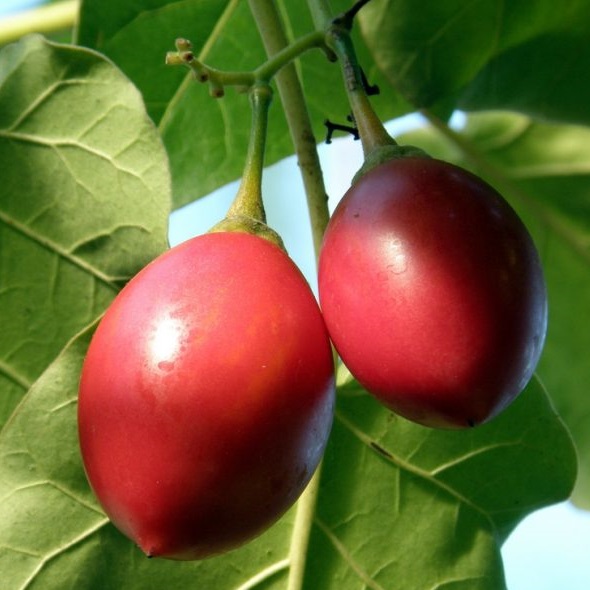Introduction:
The Tomate de Árbol, also known as the Tree Tomato or Tamarillo, is a unique and exotic fruit that hails from the Andean region of South America. Scientifically known as Solanum betaceum, this vibrant, egg-shaped fruit belongs to the Solanaceae family, which includes tomatoes, potatoes, and eggplants. The Tomate de Árbol is celebrated not only for its distinctive appearance and rich flavour but also for its numerous health benefits. In this article, we will delve into the origin, characteristics, culinary uses, nutritional value, and health benefits of the Tomate de Árbol, providing a comprehensive exploration of this fascinating fruit.
Plant origin and regions of cultivation:

The tamarillo is native to the Andes of Ecuador, Colombia, Peru, Chile, Argentina and Bolivia. Today it is still cultivated in gardens and small orchards for local production, and it is one of the most popular fruits in these regions. Other regions of cultivation are the subtropical areas throughout the world, such as Ethiopia, Burundi, Kenya, Rwanda, South Africa, Nepal, Hong Kong, China, the United States, Australia, Bhutan, New Zealand and Nagaland, Manipur, Darjeeling and Sikkim in India. It has also been seen in Cantabria, a province in Spain.
The tree tomato is a fruit harvested permanently in Colombia the average annual production exceeds 150,000 tons. Antioquia has the largest number of hectares planted with La Meseta being the place where more than 900 hectares are located and from which the main cities of the country are supplied.
In 1993, in New Zealand, about 2,000 tons were produced on 200 hectares of land and exported to the United States. By 220, there was a decrease from 150 after the discovery of the tomato potato psyllid (TPP) in 2006. This was reflected in a corresponding reduction in volume from 800 tonnes worth $3.5 million, to 250 tonnes valued at $1.3 million at that time. In 2021, growers sold 414 tonnes through the domestic wholesalers at a value of $3.1 million, and 8 tonnes exported to the USA from two growers at a value of $0.02 million. Japan and Europe. For the export, the existing marketing channels developed for the kiwifruit are used.
The first internationally marketed crop of tamarillos in Australia was produced around 1996.
The tamarillo is also successfully grown at higher elevations of Malaysia and the Philippines, Ethiopia and in Puerto Rico. In the hot tropical lowlands, it develops only small fruits and fruit setting is seldom.
Prior to 1967, the fruit was known as the ‘tree tomato’, but the New Zealand Tree Tomato Promotions Council dubbed it the ‘tamarillo’ in order to distinguish it from the ordinary garden tomato and increase its exotic appeal. However, the name ‘tamarillo’ is not universally used, and this plant has a different name in many regions.
Also Read This: Kanikama: Exploring the Culinary Delight Carb Sticks
Characteristics and Varieties:
The Tomate de Árbol is visually striking, with its glossy, smooth skin ranging in colour from deep red and orange to yellow and purple. The fruit typically measures around 5 to 10 centimetres in length and has a slightly pointed end. The inner flesh varies in colour, usually being orange or yellow, and is filled with small, edible seeds.

Several varieties of Tomate de Árbol exist, each with its unique characteristics. Some varieties are sweeter, while others may have a more tangy or tart flavour profile. The diversity in varieties allows for culinary versatility, as the fruit can be used in both sweet and savory dishes.
Culinary Uses:
The Tomate de Árbol is a versatile fruit that can be incorporated into a wide range of culinary creations. Its unique flavour, which is a harmonious blend of sweetness and acidity, makes it suitable for various dishes. Here are some popular culinary uses of the Tree Tomato:
- Fresh Consumption:

The most straightforward way to enjoy Tomate de Árbol is by consuming it fresh. Simply cut the fruit in half and scoop out the flesh with a spoon. The sweet and tangy flavour makes it a refreshing snack.
2. Juices and Smoothies:

The fruit’s pulpy consistency and vibrant taste make it an excellent addition to juices and smoothies. Blending Tomate de Árbol with other fruits creates a delicious and nutritious beverage.
3. Salsas and Chutneys:

The Tomate de Árbol’s unique flavour profile enhances the taste of salsas and chutneys. It can be diced and mixed with ingredients like onions, cilantro, and chili peppers for a zesty accompaniment to various dishes.
4. Preserves and Jams:

Due to its natural pectin content, Tomate de Árbol is suitable for making preserves and jams. Boiling the fruit with sugar results in a delightful spread that can be enjoyed on toast or as a topping for desserts.
5. Desserts:

Incorporating Tomate de Árbol into desserts such as cakes, pies, and sorbets adds a distinctive twist. The fruit’s vibrant colour and complex flavour make it a standout ingredient in sweet treats.
Nutritional Value:
Beyond its delectable taste and culinary versatility, the Tomate de Árbol boasts an impressive nutritional profile. Rich in vitamins, minerals, and antioxidants, this fruit offers numerous health benefits. Here is a breakdown of the nutritional components of the Tree Tomato:

1. Vitamins:
Tomate de Árbol is a good source of vitamin C, providing a significant portion of the recommended daily intake. Vitamin C is essential for immune system function, collagen formation, and antioxidant protection.
2. Minerals:
The fruit contains minerals such as potassium, magnesium, and phosphorus, which play vital roles in maintaining proper bodily functions, including heart health and bone strength.
3. Dietary Fiber:
Tomate de Árbol is high in dietary fibber, aiding in digestion and promoting a healthy gut. Fiber also contributes to a feeling of fullness, which can be beneficial for weight management.
4. Antioxidants:
The fruit is rich in antioxidants, including carotenoids and flavonoids, which help combat oxidative stress and inflammation in the body. These compounds contribute to overall health and may play a role in preventing chronic diseases.
5. Low Caloric Content:
Tomate de Árbol is relatively low in calories, making it a nutritious option for those watching their calorie intake. It provides essential nutrients without contributing significantly to overall caloric intake.
Health Benefits:

The consumption of Tomate de Árbol is associated with several health benefits, making it a valuable addition to a balanced diet. Some of the notable health benefits include:
1. Immune System Support:

The high vitamin C content in Tomate de Árbol supports the immune system by promoting the production of white blood cells and enhancing the body’s ability to fight infections.
2. Heart Health:

Potassium, present in significant amounts in Tree Tomatoes, is known for its role in regulating blood pressure. Including Tomate de Árbol in the diet may contribute to cardiovascular health by helping to maintain healthy blood pressure levels.
3. Digestive Health:

The dietary fibber in Tomate de Árbol aids in digestion and helps prevent constipation. A diet rich in Fiber is associated with a lower risk of digestive issues and promotes a healthy gut microbiome.
4. Antioxidant Protection:

The antioxidants in Tomate de Árbol help neutralize free radicals in the body, reducing oxidative stress and inflammation. This may contribute to a lower risk of chronic diseases and support overall well-being.
5. Skin Health:

The combination of vitamin C and antioxidants in Tomate de Árbol promotes skin health by supporting collagen synthesis and protecting against damage from UV rays and environmental pollutants.
Frequently Asked Questions (FAQs):
1. Can Tomate de Árbol be eaten with the skin?
While the skin of Tomate de Árbol is edible, some people prefer to remove it due to its slightly bitter taste. If consuming the skin, it’s advisable to wash the fruit thoroughly to remove any contaminants.
2. How do you choose a ripe Tomate de Árbol?
A ripe Tree Tomato should have a firm texture with a slight give when gently squeezed. The skin’s colour may vary depending on the variety, but it should be vibrant and free from wrinkles or blemishes.
3. What is the best way to store Tomate de Árbol?
Store ripe Tomate de Árbol in the refrigerator to prolong its freshness. If the fruit is not fully ripe, it can be left at room temperature to ripen. Once
